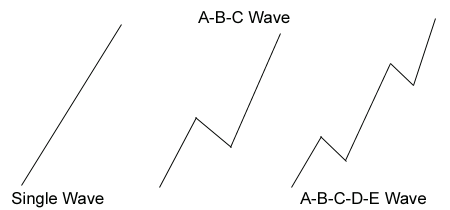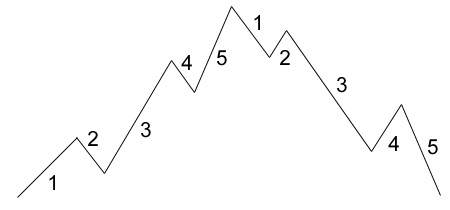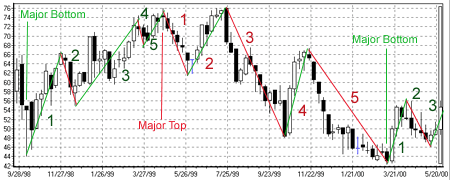| Elliot
Wave Basics
 Elliot
wave theory is very similar to the candlestick "Three
Level Fluctuation" theory. The Japanese detailed
the belief that the market typically moves in three
defined waves to complete a major trend. Between these
three waves, there will be corrective waves. Thus, the
Japanese described the Elliot Wave theory hundreds of
years before the West became aware of it. So... in the
following paragraphs, when I refer to The Elliot Wave
Theory or the Three Level Fluctuation Theory, I am refering
to both, one and the same so to say. Elliot
wave theory is very similar to the candlestick "Three
Level Fluctuation" theory. The Japanese detailed
the belief that the market typically moves in three
defined waves to complete a major trend. Between these
three waves, there will be corrective waves. Thus, the
Japanese described the Elliot Wave theory hundreds of
years before the West became aware of it. So... in the
following paragraphs, when I refer to The Elliot Wave
Theory or the Three Level Fluctuation Theory, I am refering
to both, one and the same so to say.
The
Elliot wave theory first teaches us the following.
1.
There should be five complete waves with a defined price
move.
2.
Each wave can consist of a Single Wave, A-B-C Wave or
A-B-C-D-E Wave. Thus, any individual wave may consist
of any of the three types of wave variations.
3.
The peak/valley of wave #3 should be higher/lower than
the peak/valley of wave #1.
4.
The valley/peak of wave #4 should be higher/lower than
the valley/peak of wave #1.
5.
Wave #3 and wave #5 are typically the longest/strongest
waves.
 When
traders are attempting to use the Elliot wave theory,
one has to remember this is a very subjective type of
analysis. If you are able to properly count the waves,
they can provide great assistance. Trading waves #3
and #5 can be very exciting and profitable. The problem
here is that if it often difficult to properly count
the waves as they are forming. This presents a new dilema
for traders - how can you rely on the Elliot wave theory
if you can't actually rely on the technique as the market
is moving?? When
traders are attempting to use the Elliot wave theory,
one has to remember this is a very subjective type of
analysis. If you are able to properly count the waves,
they can provide great assistance. Trading waves #3
and #5 can be very exciting and profitable. The problem
here is that if it often difficult to properly count
the waves as they are forming. This presents a new dilema
for traders - how can you rely on the Elliot wave theory
if you can't actually rely on the technique as the market
is moving??
Here
are a couple of tips for traders....
1.
Only use the Elliot Wave throry is you are able to correctly
could two or more previously completed elliot wave formations.
2.
Only attempt to trade Elliot Wave #3 and/or #5. Properly
identifying the end of an Elliot Wave 5 count can be
risky. Often one thinks the end of the count is now
and it actually continues to form an A-B-C or A-B-C-D-E
wave - thus creating further losses.
3.
The best entry for trading the Elliot Wave patterns
is to enter as wave #3 and/or #5 begins. If you wait
for the beginning of these waves, you will in effect
be waiting for the market to rally or selloff before
you get in.
4.
Remember to do your homework on the chart before you
leap in. Also, use proper money management techniques
to protect against unwanted losses.

| 
